Shooting action scenes are said to be quite tough, with Car chases and fight scenes being especially difficult. I thought it was time to teach my self about how to shoot action so I contacted my stuntmen friends Glenn Chow and Ryan Tarran and arranged to meet up and talk over some ideas and get some practice under my belt.
Fight!
The thing about fight scenes is they look quite simple from a camera perspective most of the time, it’s the martial arts and choreography that looks complicated. But when you look into it most fight scenes have a lot more cuts and angles than you first realize and most a far more complicated than you think.
We did a first test with Glenn & Ryan at an oval near Ryan’s place. Just getting a feel for where to put the camera and what works on-screen. Ryan and Glenn went through a choreographed fight they had been working on. I filmed them largely with out a plan, just trying to capture the action. There fight moves were very cool but the lack of a plan showed and I didn’t get anything usable, at least nothing I was willing to show anyone. Both Ryan & Glenn are really talented so I felt a bit like I let the guys down But as Ryan says we are here to learn and practice. So we will come back again and keep improving.
So the first lesson I learned was always have a plan. This is something I think is really actually common sense for most work but oddly enough I really hadn’t appreciated the lesson fully until now.
Second lesson was that the action just blurred too much, it didn’t look sharp and it didn’t look fast. Moving the shutter to a faster setting rather than the 180 degrees that it was on is a must.
Reading into the films of Jackie Chan I noticed that much of their action is filmed at a frame or two below playback making the final image just a bit faster, yet still believable and not looking too much like it has been speed up.
Glenn Wins!
We got back into it after the first test. This time we went to Ryan’s place, and, we have a plan! The best thing you can do to improve your chances of success is to make a plan. So our goal was to simply make a small fight sequence and film it so we could put a basic edit together. Keeping in mind the lessons learned from last time I set the shutter to 120th of a second and I set the frame rate to 23 frames per second to play back at 25 frames per second.
This time I really noticed how much is in focus in action movies. In general I think we often make the mistake of opening up the iris too far to get a very shallow depth of field. I guess this is a reaction of the years of fighting with small chip cameras. But now that we have easy access to large sensor cameras we no longer have to shoot every thing wide open. But habits are hard to break so I shot this one at f2.8 mostly on the Tamron 17-50. I now feel that shooting at a higher f-stop is a better option and when I watch action movies more often there is a lot in focus. In fact I find that most big Hollywood movies have a much larger DOF than i realized.
I spoke to my friend, the super talented John Brock ACS and asked him about it. He said that most of the time they are operating between f4 and f8 giving the focus puller a reasonable amount of DOF to work with.
We were much happier with the results and we are starting to get an idea about how to break down and shoot a fight sequence. The above video is the result. Its short, with no sound, but it was a good step forward.
Raw Deal!
We have a friend with an old building that is soon to be gentrified so we thought it would be a cool place for our next fight test.We want to eventually be able to shoot something of a high quality so we will be improving every aspect we can step by step. The empty building sure ads some production value/set design.
We recently watched Universal Soldier Day of Reckoning, which we all enjoyed. The stunts in the film are very impressive and one of the stylistic elements that caught Ryan’s eye was the slow motion hits and speed ramping. So we thought we might give it a shot. Experimenting is what we are here for.
We shot again with the AF100 this time at 60 fps and with a shutter speed of 240th of a second. We then converted the video back to 24 fps.
Here is our fight test at 24 fps:
What we found was that once back to normal speed the motion blur looked weird with almost half frames in with the motion blur, like two exposures.
Here it is at the original 60 fps:
At 60 fps slow motion it looked good but as its not really used to any effect it kind of gets boring. After re watching some action movies that use the effect it really is better suited to big hits or when a bad guy is dispatched for good.
*Update* In FCP7 you can deselect “Frame Blending” this fixes the ‘double exposure’ issue we were having. Simple fix really, just needed to open my eyes. Thanks to Matt Gorrie for the tip.
The other thing we played with was ‘Crossing the Line’ which is a bit of a no-no in drama shooting. Action films are more likely to break this rule than other films simply because the frenetic movement can disguise the cut. Having strong imagery associated with the characters helps as well.
Finish Him!
We were back at the old building to go through the plan (gotta have a plan) for our next little shoot.
The way we have been approaching things has been to start by deciding what it is we want to achieve, then figure out how to do it. So this is just a walk through as we figure out the sequence then later break it down into camera angles and any effects we might want to try.
We wanted to make a cool fight sequence that gets into the action as fast as possible but still carrying a bit of inferred story elements. In our set up Ryan is on the run from some attackers and is ambushed by Glenn. Ryan then has to use his superior strength to bust his way past Glenn’s more skilled attacks and finally dispatch Glenn.
I wanted to show Ryan as being bigger and stronger by having his hits knock Glenn back each time like he was coming down on Glenn like a pile of bricks. Have a look…
Ultimately Glenn was unable to continue due to other commitments so Ryan has invited his Friend Stephen Murdock into the mix and we will work on a new fight.
Lessons
- Always have a plan.
- 180 Degree shutter is too slow for action
- Record at 1 or 2 frames less than your playback frame rate to make the action look faster. for 25p record at 23 or 24 fps.
- Larger DOF is your friend.
- To much slowmo is not a good thing.
- Crossing the line is less of a worry in action.
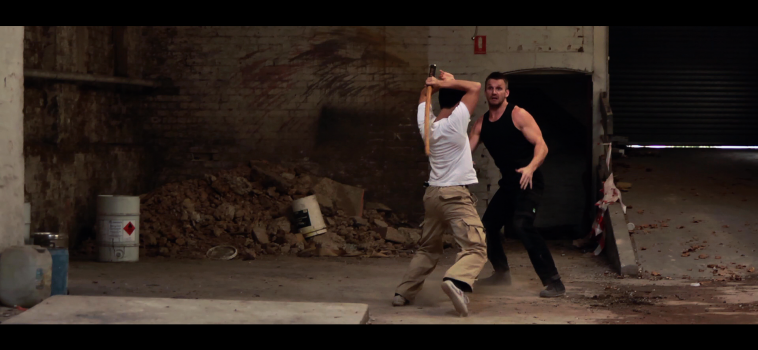







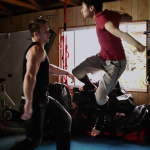
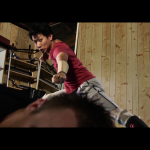

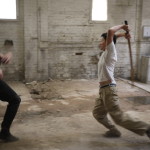
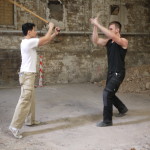
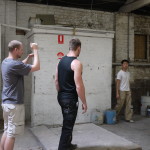
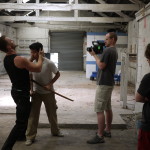
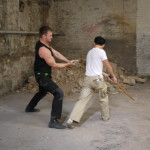
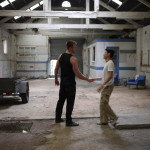
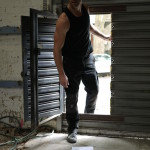



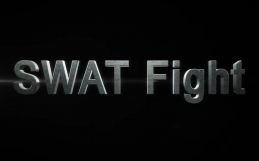



[…] shoot action. It was a big learning experience in many ways. You can read a bit about it here and here, you can also check out the finished fight scene we did […]